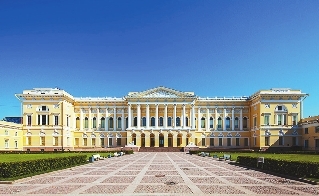
The State Russian Museum is the world’s largest collection of Russian art, housed in a unique architectural complex in the historical center of St. Petersburg.
The museum was established April 13, 1895, upon enthronement of Nicholas II to commemorate his father, Alexander III. Its original collection was composed of artwork taken from the Hermitage Museum, Alexander Palace, and the Imperial Academy of Arts. After the Russian Revolution of 1917, many private collections were nationalized and relocated to the Russian Museum. These included Kazimir Malevich’s Black Square.
The main complex of museum buildings — the Mikhailovsky Palace and Benois Wing — houses the permanent exhibition of the Russian Museum, tracing the entire history of Russian art from the 10th to the 20th centuries.
The Mikhailovsky Palace is a splendid Neoclassical residence of Grand Duke Michael Pavlovich, erected in 1819-25 to a design by Carlo Rossi on Arts Square in St. Petersburg. Upon the death of the Grand Duke the residence was named after his wife as the Palace of the Grand Duchess Elena Pavlovna, and became famous for its many theatrical presentations and balls.
Unlike the Tretyakov Gallery, the Russian Museum continues to exhibit art from all periods in one space. Since the Revolution, the Russian Museum has also become the curator of three of St. Petersburg’s most significant historical buildings, giving the museum the opportunity to exhibit yet more of its vast collection.
Today, the museum is in the area of a complex covering more than 30 hectares. The museum’s collection includes over 400,000 artworks. The collection is accommodated in buildings that are outstanding monuments of the XVIII-XIX century architecture: Mikhailovsky, Stroganov, Marble Palaces and Mikhailovsky Castle. Mikhailovsky Garden, Summer Garden and Peter I’s Summer Palace as well as Cabin of Peter the Great are also part of the museum complex.(SD-Agencies)
Editor: Jane Chen